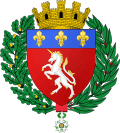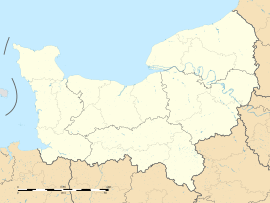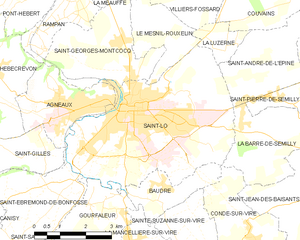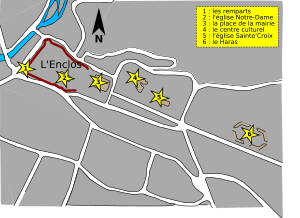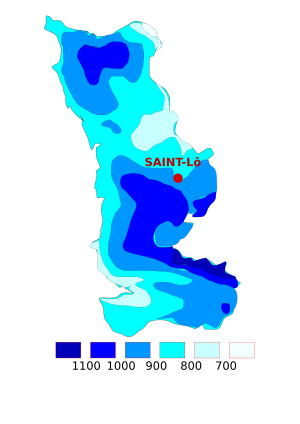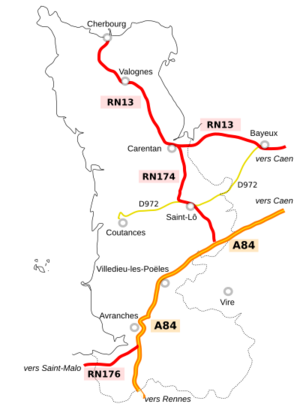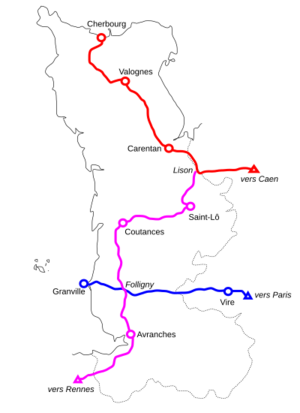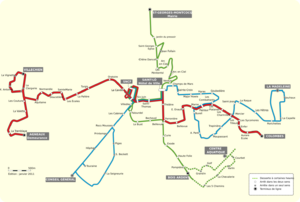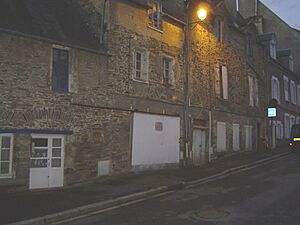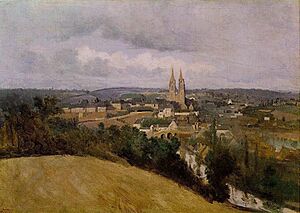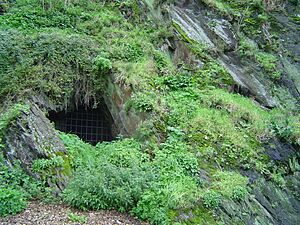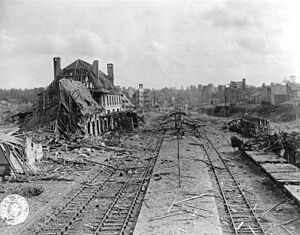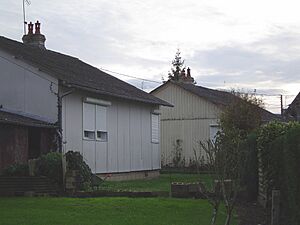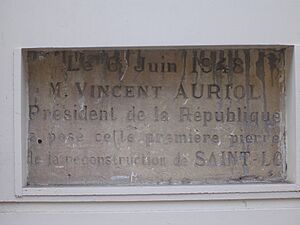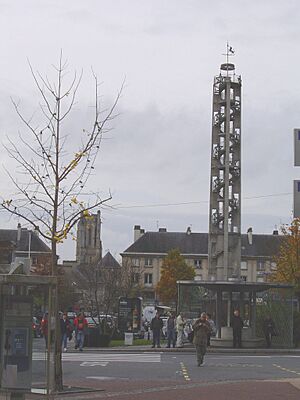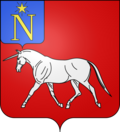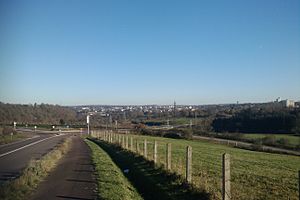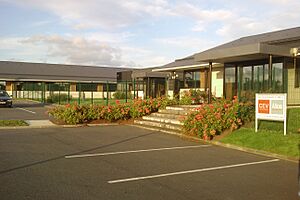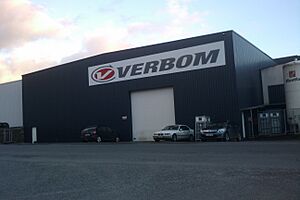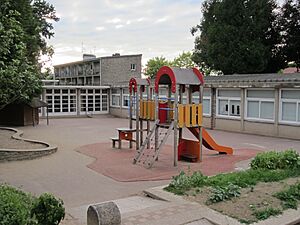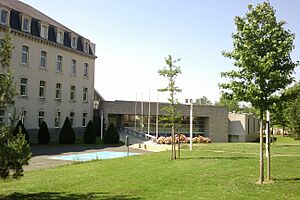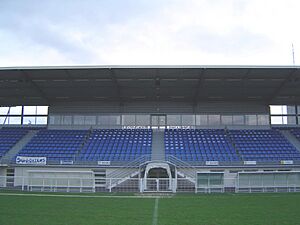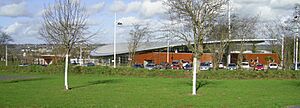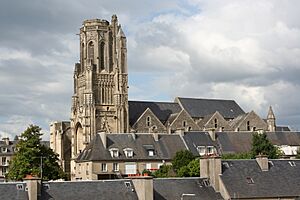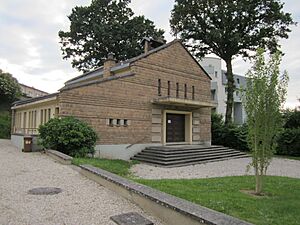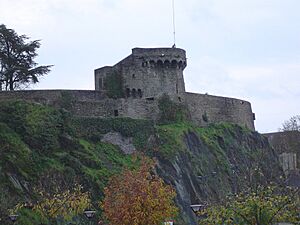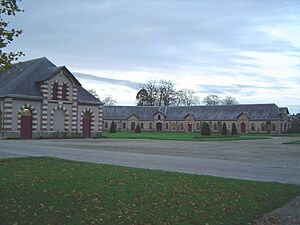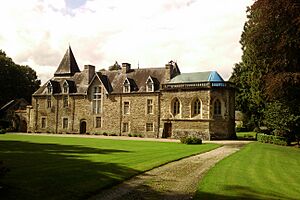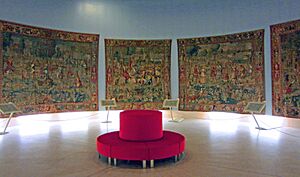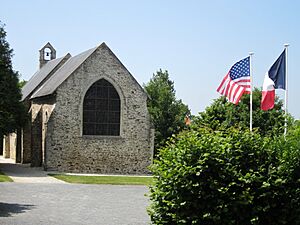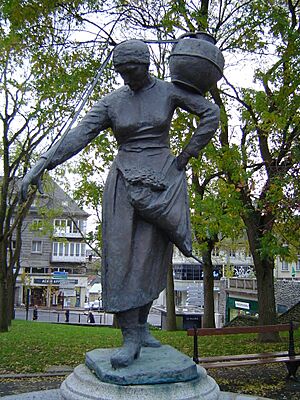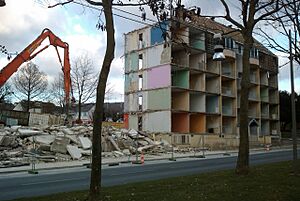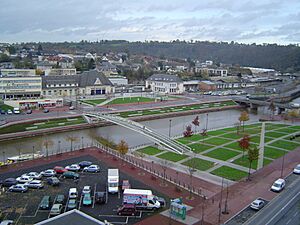Saint-Lô facts for kids
Quick facts for kids
Saint-Lô
|
||
|---|---|---|
|
Prefecture and commune
|
||
![A view of Saint-Lô from the Notre-Dame church [fr]](/images/thumb/b/b2/Vue-Est-depuis-Notre-Dame-Saint-Lo.JPG/270px-Vue-Est-depuis-Notre-Dame-Saint-Lo.JPG)
A view of Saint-Lô from the Notre-Dame church
|
||
|
||
| Country | France | |
| Region | Normandy | |
| Department | Manche | |
| Arrondissement | Saint-Lô | |
| Canton | Saint-Lô-1 and 2 | |
| Intercommunality | Saint-Lô Agglo | |
| Area
1
|
23.19 km2 (8.95 sq mi) | |
| Population
(2021)
|
19,373 | |
| • Density | 835.40/km2 (2,163.7/sq mi) | |
| Time zone | UTC+01:00 (CET) | |
| • Summer (DST) | UTC+02:00 (CEST) | |
| INSEE/Postal code |
50502 /50000
|
|
| Elevation | 7–134 m (23–440 ft) (avg. 14 m or 46 ft) |
|
| 1 French Land Register data, which excludes lakes, ponds, glaciers > 1 km2 (0.386 sq mi or 247 acres) and river estuaries. | ||
Saint-Lô is a town in northwest France. It is the capital of the Manche area in the Normandy region. Even though it's the second-largest city in Manche, it's still the main administrative center.
The town is also home to an arrondissement (a type of district) and two cantons (smaller administrative areas). Its name comes from a local saint, Laud of Coutances. About 19,000 people live here. Saint-Lô was heavily damaged during World War II. Because of this, it was given the nickname "Capital of the Ruins."
Contents
- Exploring Saint-Lô's Location and Climate
- Getting Around Saint-Lô: Transport Options
- A Look Back: Saint-Lô's History
- Population and Demographics of Saint-Lô
- Understanding Saint-Lô's Coat of Arms
- Saint-Lô's Economy and Industries
- Learning in Saint-Lô: Education
- Military Presence in Saint-Lô
- Culture and Events in Saint-Lô
- Famous People Connected to Saint-Lô
- Sports and Recreation in Saint-Lô
- Important Places and Buildings in Saint-Lô
- Saint-Lô's Neighborhoods
- Parks and Green Spaces in Saint-Lô
- Sister Cities and Sponsorships
- Saint-Lô on a Stamp
- See also
Exploring Saint-Lô's Location and Climate
Where is Saint-Lô Located?
Saint-Lô is right in the middle of the Manche area. It's in a countryside region called the Saint-Lois bocage, which has lots of small fields and hedges. The town is about 57 km (35 mi) west of Caen and 78 km (48 mi) south of Cherbourg.
The city started as Briovera on a rocky hill. This hill is part of the Armorican Massif in the Cotentin Peninsula. The Vire River flows through the city center. Two smaller rivers, the Dollée and Torteron, also join the Vire here. The oldest part of the city, called L'Enclos, was a good place for defense.
What is Saint-Lô's Climate Like?
Saint-Lô has a mild oceanic climate. This means it has mild winters and warm, but not too hot, summers. It usually gets about 800 to 900 mm (31 to 35 inches) of rain each year. Rain falls often, especially in autumn and winter, due to weather systems from the Atlantic Ocean. It's usually light rain or drizzle. The average temperature is about 10 °C (50 °F). In winter, temperatures are usually between 1 and 7 °C (34 and 45 °F). There are about 30 to 40 days of frost each year. In summer, the average temperature is around 20 °C (68 °F).
Getting Around Saint-Lô: Transport Options
How Do People Travel by Road?
Saint-Lô is a central point for roads in Manche. It's halfway between Coutances and Bayeux. A bypass road was built in the 1980s to help traffic flow better around the city. A new dual carriageway, the RN 174, connects Saint-Lô directly to the A84 motorway. This makes it easier to reach Caen and Rennes. The northern part of this road will soon connect to Cherbourg and England.
What About Train Travel?
The Gare de Saint-Lô (Saint-Lô train station) has TER trains. These trains run on the line between Caen and Rennes. Most trains go towards Caen or Coutances. A few trains also go to Rennes. There was once a direct train service to Paris, but it stopped because not enough people used it.
How Does Urban Transport Work?
Saint-Lô has a local bus network called TUSA. It started in 1980. The network has three main lines (1, 2, and 3) and a special minibus service called Ocitolà for on-demand transport. In 2008, the buses made over 850,000 trips. New, more accessible buses have been added to the fleet.
| Route | Main Areas Served |
|---|---|
| 1 | Saint-Lô-Colombes, Agneaux-Villechien, Commercial Centre, Pasteur College, City Hall, Train Station |
| 2 | Hospital, Lavalley College, Train Station, City Hall, Cultural Centre, Sainte Croix Church, St. Jean Clinic |
| 3 | Bois Ardent, Aquatic Centre, Commercial Centre, Corot & Curie schools, Train Station, City Hall, Mont Russel Lift |
| Ocitolà | Transport on demand for the whole local area. |
Are There Other Ways to Travel?
Saint-Lô does not have its own airport. The closest airports are in Lessay, Caen, Cherbourg, or Rennes.
In the past, boats called scows used to transport goods on the Vire River. However, this is no longer possible because the river is not maintained for transport.
A Look Back: Saint-Lô's History
Saint-Lô has always been an important place in Normandy. It was often desired by other nations, like England, leading to many invasions. It lost some importance in the late 1800s because it didn't join the first Industrial Revolution as much. But later, new policies helped the city grow again.
Ancient Times: Briovera
The town was first called Briovera, which means "Bridge on the Vire River" in an old language called Gaulish. It was built on and around strong walls. It started as a fortified settlement by a Gaulish tribe. The Romans took over in 56 BC. Later, Saxons invaded in the 3rd century.
Christianity came to the area later. Laud of Coutances, a bishop from 525 to 565, lived here. After he died, he was honored, and the town was renamed Saint-Laud, which became Saint-Lô by the 8th century.
The Middle Ages: Growth and Challenges
In 889, Vikings attacked Saint-Lô. The town had strong walls, but the Vikings cut off its water supply, forcing the people to surrender. The Vikings destroyed the town and killed many people. The bishop's seat moved away. It wasn't until 1025 that the bishop returned and rebuilt.
Saint-Lô became known for its goldsmiths. Even Matilda of Flanders, wife of William the Conqueror, ordered items from here. The town helped in the conquest of England. In 1204, Saint-Lô became part of France. During this peaceful time, the town grew. It built a hospital and part of the Notre-Dame church.
Saint-Lô was the third-largest town in Normandy after Rouen and Caen. It was allowed to make its own coins until 1693. It was famous for leather goods, knife making, and textiles. Over 2,000 weavers worked here.
In 1346, during the Hundred Years' War, the English attacked and looted Saint-Lô.
From the 1500s to the 1900s
After the war, peace returned, but the Cotentin area became less important. In the 16th century, Protestantism became popular in Saint-Lô. The town suffered during the Wars of Religion. Protestant troops held Saint-Lô, but it was later captured by French forces in 1574.
Many skilled workers left Saint-Lô after the Edict of Nantes was canceled in 1685. The town's economy changed, focusing on wool socks. A new road between Paris and Cherbourg, built in 1761, helped trade. The French Revolution changed France's administration. Saint-Lô was briefly called "Rock of Freedom."
In the 1800s, the Vire River was made navigable, allowing boats to transport goods like lime. A paper mill was built but later destroyed by fire in 1930. Saint-Lô didn't get a railway connection to Paris until 1860 because people feared industrial progress. The city focused on animal trade due to its rich farming area. However, the fear of industrial change slowed its growth. The population declined due to people moving away and losses from wars.
World War II: The Capital of Ruins
In 1940, German forces occupied Saint-Lô because it was a key crossroads. During the occupation, some local statues were melted down for cannons. In 1943, the Germans started digging a tunnel under the city's rock. This tunnel later became a shelter for sick people and residents during the war.
Saint-Lô was bombed twice during the Battle of Normandy. The first time was on the night of D-Day, June 6–7, 1944, by American planes. This attack killed about 800 civilians. Allied planes continued to bomb the city's power plant and railway for a week.
The second series of attacks happened on July 17, during the Battle of Saint-Lô, this time by the Germans. Saint-Lô was a vital transport hub for the war. As a result, 90-95% of the city was destroyed. It was called "The Capital of the Ruins" by writer Samuel Beckett. Saint-Lô was crucial for the Allies to push German forces out of northern France.
An American soldier, Major Thomas Howie, was killed just before his unit entered the city. His men placed his body, covered by a flag, on a jeep so he could be the first American to enter Saint-Lô.
Saint-Lô received the Legion of Honour and the Croix de Guerre awards in 1948 for its bravery.
Rebuilding Saint-Lô After the War
After the war, people wondered if Saint-Lô should be rebuilt or left as ruins to remember the bombing. An American soldier famously said, "We sure liberated the hell out of this place."
The city was almost completely destroyed (97%). The nickname "Capital of Ruins" stuck. People slowly returned. A long cleanup process began, including removing bodies, which lasted until October 1944.
In 1945, temporary wooden barracks were built using donations from countries like Switzerland. These huts came in kits and were quickly assembled. The Irish Red Cross even built a 100-bed hospital from 25 wooden buildings. This temporary hospital operated until 1956.
By 1948, plans for a permanent Saint-Lô were made. The goal was to keep the city's general layout but update it for modern needs. The first stone of the reconstruction was laid four years after the bombings.
As a way to help after the destruction, the Americans built a modern hospital. It was designed by architect Paul Nelson and finished in 1956. It featured a huge mosaic by Fernand Léger celebrating peace and friendship between France and America. At the time, it was the largest hospital in Europe. The main administrative office (prefecture) returned to Saint-Lô in 1953.
Saint-Lô was rebuilt using a style that mixed new and old designs, mostly with concrete. While some found it a bit plain, it stands as an important example of postwar reconstruction. A few streets still show parts of the old Saint-Lô, like Rue Saint-Georges.
In 1964, Saint-Lô grew by taking in two nearby towns. The city's population grew by 30% between 1968 and 1975. New neighborhoods and a theater were built.
In the 1990s, the town hall square was redesigned. The areas along the Vire River were improved with a walking path and a "green beach." A traditional boat was even rebuilt to remember the old river traffic. In 2004, a new area with housing and a large aquatic center was developed. A unique water tower was also built, with its tank resembling a flying saucer, which was lifted into place by jacks.
Population and Demographics of Saint-Lô
How Has Saint-Lô's Population Changed?
In 2017, Saint-Lô had 19,116 residents.
| Historical population | |||||||||||||||||||||||||||||||||||||||||||||||||||||||||||||||||||||||||||||||||||||||||||||||||||||||||||||||||||||||
|---|---|---|---|---|---|---|---|---|---|---|---|---|---|---|---|---|---|---|---|---|---|---|---|---|---|---|---|---|---|---|---|---|---|---|---|---|---|---|---|---|---|---|---|---|---|---|---|---|---|---|---|---|---|---|---|---|---|---|---|---|---|---|---|---|---|---|---|---|---|---|---|---|---|---|---|---|---|---|---|---|---|---|---|---|---|---|---|---|---|---|---|---|---|---|---|---|---|---|---|---|---|---|---|---|---|---|---|---|---|---|---|---|---|---|---|---|---|---|---|
|
|
|
|||||||||||||||||||||||||||||||||||||||||||||||||||||||||||||||||||||||||||||||||||||||||||||||||||||||||||||||||||||
| From 1962 to 1999: Population without double counting; for the years following: municipal population. Source: Ldh/EHESS/Cassini until 1999 and INSEE (1968-2017) |
|||||||||||||||||||||||||||||||||||||||||||||||||||||||||||||||||||||||||||||||||||||||||||||||||||||||||||||||||||||||
Population of Sainte-Croix-de-Saint-Lô (joined Saint-Lô in 1964)
| Historical population | |||||||||||||||||||||||||||||||||||||||||||||||||||||||||||||||||||||||||||||||||||||||||||||||||||
|---|---|---|---|---|---|---|---|---|---|---|---|---|---|---|---|---|---|---|---|---|---|---|---|---|---|---|---|---|---|---|---|---|---|---|---|---|---|---|---|---|---|---|---|---|---|---|---|---|---|---|---|---|---|---|---|---|---|---|---|---|---|---|---|---|---|---|---|---|---|---|---|---|---|---|---|---|---|---|---|---|---|---|---|---|---|---|---|---|---|---|---|---|---|---|---|---|---|---|---|
|
|
|
|
||||||||||||||||||||||||||||||||||||||||||||||||||||||||||||||||||||||||||||||||||||||||||||||||
| Number withheld from 1962: Population without double counting. Source: EHESS |
|||||||||||||||||||||||||||||||||||||||||||||||||||||||||||||||||||||||||||||||||||||||||||||||||||
Population of Saint-Thomas-de-Saint-Lô (joined Saint-Lô in 1964)
| Historical population | |||||||||||||||||||||||||||||||||||||||||||||||||||||||||||||||||||||||||||||||||||||||||||||||||||
|---|---|---|---|---|---|---|---|---|---|---|---|---|---|---|---|---|---|---|---|---|---|---|---|---|---|---|---|---|---|---|---|---|---|---|---|---|---|---|---|---|---|---|---|---|---|---|---|---|---|---|---|---|---|---|---|---|---|---|---|---|---|---|---|---|---|---|---|---|---|---|---|---|---|---|---|---|---|---|---|---|---|---|---|---|---|---|---|---|---|---|---|---|---|---|---|---|---|---|---|
|
|
|
|
||||||||||||||||||||||||||||||||||||||||||||||||||||||||||||||||||||||||||||||||||||||||||||||||
| Number withheld from 1962: Population without double counting. Source: EHESS |
|||||||||||||||||||||||||||||||||||||||||||||||||||||||||||||||||||||||||||||||||||||||||||||||||||
What is the Age Breakdown in Saint-Lô?
In 2017, here's how the population of Saint-Lô was divided by age:
|
|
||||||||||||||||||||||||||||||||||||||||||||||||||||||||||||||||||||||||||||||||||||||||||||||||||||||||||||||||||||||||||||||||||||||||||||||||||||||||||||||||||||||||||||||||||||||||
Understanding Saint-Lô's Coat of Arms
| The coat of arms for Saint-Lô shows a red background with a silver unicorn standing up. At the top, on a blue stripe, there are three gold fleurs-de-lis.
|
| During the time of the First Empire, the city had a different coat of arms. It showed a red background with a silver unicorn walking. On a blue shield, there was a gold letter "N" with a gold star above it.
|
| This image shows the full coat of arms for the city of Saint-Lô.
|
Saint-Lô's Economy and Industries
Saint-Lô is located at a crossroads between Caen, Cherbourg, and Rennes. This makes it a natural place for trade and markets in the center of the Manche region. It has a history of skilled workers and trade. Being the capital of the department also helps its economy.
The city's industrial growth happened later than in some other places. Today, it's trying to grow its food and agriculture industries. Even so, the Saint-Lô area is one of the less industrial parts of the region. The unemployment rate is 6.7%, but many young workers move to Caen or Rennes for jobs. A new road, the RN 174, has helped open up the center of Manche and create new business areas.
In 2008, Saint-Lô started getting fiber optic internet. This allows companies and people to have very fast internet. Saint-Lô was one of the first cities of its size in France to have this.
What are the Main Industries in Saint-Lô?
- Lecapitaine: This company makes car bodies and refrigeration units.
- Moulinex: The Moulinex factory used to be the biggest in Saint-Lô. It made small electric motors. The factory closed in 2007.
- Alios and CEV: These companies make smart cards and manage electronic payments. They are part of a group that focuses on secure electronic transactions.
- MT Verbom: This company specializes in tools for pressing metal, especially for car parts.
What About Services and Agriculture?
Saint-Lô has many jobs in the service sector. The France-United States Memorial Hospital is the largest employer. Many people also work in government jobs because Saint-Lô is the capital of the department.
Because it's in a farming area, Saint-Lô also has services linked to agriculture. For example, there are offices for agricultural banks and insurance companies. Many businesses have also opened along the bypass road.
The city is important for raising cattle and horses. There used to be a calf market every week, but it moved to a nearby town in 2009. Saint-Lô also has a Livestock Promotion Centre, which hosts horse competitions every August.
Since 1990, the city has developed a food and agriculture hub. This area aims to attract companies in this sector. Several organizations related to food processing and agricultural training are located here.
Learning in Saint-Lô: Education
Saint-Lô is part of the Academy of Caen for education.
| Level | Public Schools | Private Schools |
|---|---|---|
| School | Primary schools like Aurore, Raymond-Brulé, Calmette-et-Guérin, Jules-Verne, Jules-Ferry, Gendrin, and Yser. | Sainte-Jeanne-d'Arc School, Sainte-Geneviève School. |
| College (Middle School) | Collège Georges-Lavalley, Collège Louis-Pasteur. | Collège du Bon-Sauveur, Collège interparoissial. |
| High School | Lycée Pierre-et-Marie-Curie, Lycée Urbain-Le Verrier, Lycée Camille-Corot. | Lycée Bon-Sauveur. |
| Further Education | National Conservatory of Arts and Crafts, National School of Dairy Industry, School of Management and Business, Graduate School of Agribusiness Executives, ESIX Normandie, Nursing Training Institute, IUFM, IUT. | |
What is the University Institute of Technology (IUT)?
The Saint-Lô branch is part of the IUT of Cherbourg-Manche. It offers various courses, including:
- DUT Multimedia Professions and the Internet (for digital media).
- DUT Thermal Engineering and Energy (for heating and energy systems).
- Professional licenses in cultural heritage, virtual reality, and industrial maintenance.
What is the School of Management and Commerce?
The School of Management and Commerce in Saint-Lô started in 1988. It offers a three-year program in marketing, sales, and management. About 40 new students join the school each year.
Military Presence in Saint-Lô
Saint-Lô has been home to several military groups at the Bellevue barracks over the years. Different infantry regiments and transport groups have been stationed here.
Culture and Events in Saint-Lô
Cultural Places to Visit
- Jean Lurçat Cultural Centre: This center has a library, a fine arts museum, an auditorium, and a drawing school.
- Municipal Music School: Where you can learn music.
- Roger Ferdinand Theatre: A place for plays and performances.
- The Normandy: A concert hall for modern music.
- Cinemoviking Cinema: This cinema opened in 2009 and was the first in Lower Normandy to show 3D films.
Fun Events in Saint-Lô
- Asian Culture Festival and Manga: Held in February.
- Housing Fair: At the Parc des Expos in late February.
- The Hétéroclites: A street theater festival in June with acrobatics and music.
- Festival of the Vire: Held at the Plage Verte (Green Beach) on the last weekend of June.
- Festival of Music: With the Tendance Live Show.
- Chess Festival: In early July.
- Criterium of the Ramparts: A cycling race around the old city walls in late July.
- Thursdays of the Stud: Events at the Saint-Lô stud farm in July and August.
- Normandy Horse Show: A big horse event in August.
- Fair of the Crusts and of the Flea Market: An art exhibition and garage sale in September.
- Polyfollia: A choral festival held every two years in October (ended in 2014).
- Challenges of the City of Saint-Lô of Shooting: A shooting competition in October.
- Fair of Saint-Lô: At the Parc des Expos in October.
- National Stallion Competition: In October.
- Sonic Meetings: A music festival in November.
Famous People Connected to Saint-Lô
People Born in Saint-Lô

- Jacques Davy Duperron (1556–1618): A poet and diplomat.
- Urbain Le Verrier (1811–1877): A famous astronomer and mathematician. He lived in Saint-Lô as a child.
- Octave Feuillet (1821–1890): A writer and playwright who was very successful. His birthplace is still in Saint-Lô.
- Jacques Datin (1920–1973): A composer who wrote songs for many famous French singers.
- Jean Teulé (1953): A novelist who also worked in film and television.
- Jacky Vimond (1961): The first French motocross rider to become a world champion in 1986.
- Hugues Duboscq: A French swimmer who won bronze medals in the Olympics.
- Alexis Loret (1975): An actor.
Other Notable People Connected to Saint-Lô
- Jean Follain: An author who wrote a book about Saint-Lô, where he spent his teenage years.
- Samuel Beckett: A Nobel Prize-winning writer who worked at the Irish Hospital in Saint-Lô after World War II. He wrote a famous text about the city called The Capital of Ruins.
- Albert II: The current Prince of Monaco, who holds the title of Baron of Saint-Lô.
- Ant Middleton: A British former special forces soldier and TV personality, who lived in Saint-Lô as a child.
Sports and Recreation in Saint-Lô
Popular Sports in Saint-Lô
Football
The FC Saint-Lô Manche football club has teams playing at different levels. Their home ground is the Louis-Villemer Stadium.
Other Sports Clubs
- Jimmer's de Saint-Lô: A Baseball team that won the French championship twice.
- Normandy Horse Show: A big annual event for horse riding and promoting saddle horses.
- Team Nissan France Dessoude: A rally raid team that competes in races like the Dakar Rally.
- ASPTT Saint-Lô Handball: A handball team.
- Saint-Lô Rugby Club: A rugby team.
- Saint-Lô Shooting Club: This club uses tunnels from an unfinished German underground hospital for shooting practice.
- Agneaux-Saint-Lô Chess Club: A very active chess club with a young team that plays in the top national division.
- Saint-Lô Volley: A volleyball team.
- Saint-Lô Floorball: The first floorball club in Manche.
- ARC Club saint-lois: An archery club.
- Patronage laïque saint-lois: A table tennis club.
Sports Facilities in Saint-Lô
- Sports Complex of Saint-Ghislain: Has a weight room, boxing hall, archery wall, stadium, and tennis courts.
- André-Guilbert – Maréchal-Juin Gym: A gym for various sports.
- Gym Hall of the Bois Ardent & Dojo Alain-Crépieux Dojo: Another gym and a dojo for martial arts.
- Table Tennis Hall: A dedicated space for table tennis.
- Complex of the Vaucelle: Includes the Jean-Berthelem Stadium and a canoeing base.
- Louis-Villemer Stadium: The main football pitch.
- Aurora Stadium: A rugby ground.
- Fernand-Beaufils Sports Centre: For basketball and fencing.
- Aquatic Centre: Opened in 2005, it has a 25-meter pool with a movable floor, a fun leisure pool, a wading pool, an outdoor pool, and a gym area.
- Memorial Tennis Club: Tennis courts near the hospital.
- Equestrian Centre of the Gourmette saint-loise: For horse riding.
- Squash: Courts near the aquatic center.
- Compact Golf: A golf course.
- Archery Field: For archery practice.
- Baseball Field: For baseball games.
Important Places and Buildings in Saint-Lô
Religious Buildings
Notre-Dame Church
The Notre-Dame church is a beautiful Flamboyant Gothic style building. It was built over four centuries, starting in the late 1200s. It's located inside the old city walls and became a historic monument in 1840. The outdoor pulpit was admired by writer Victor Hugo.
The church was badly damaged during World War II. Even though it was one of the few buildings left standing, its roof and front were destroyed. Instead of rebuilding it exactly as it was, architects decided to use a different stone for the new front. This highlights the damage from the war. A statue of Notre-Dame du Pilier from 1467 is now inside the church.
Sainte-Croix Church
The Sainte-Croix church is said to be built on the site of a chapel from the 4th century. An abbey was founded here in 1132. The original Romanesque church was built in 1202 and changed many times over the centuries. During World War II, its bell tower collapsed. A new, modern bell tower was built in 1957. Outside the church, there's a monument to remember victims of the wars in Algeria and Indochina.
Saint-Lô Cemetery
The cemetery is near the Sainte-Croix Church and the national stud farm. It has a special section for civilians who died in the 1944 bombings. You can also find the tomb of a French revolutionary general, Dagobert. A weeping statue with shrapnel marks also stands there.
Other Religious Places
Saint-Lô also has other Catholic churches and chapels, including:
- Saint Jean-Eudes Church
- Chapels at the Memorial Hospital, Saint Jean clinic, and Bon-Sauveur psychiatric hospital
- John XXIII Chapel
The city also has a Protestant church, which was opened in 1955.
Historical Civil Buildings and Sites
Several places in Saint-Lô are protected as historic monuments:
- The Madeleine Chapel.
- The Château de la Vaucelle.
- The National Stud and its park.
- Parts of the France-United States Memorial Hospital.
- The Manor of Bosdel.
- The remains of the old city walls.
Some old buildings, like the Maison-Dieu and the Poids Royal, were destroyed during the 1944 bombings.
The Old City Walls
Saint-Lô still has parts of its medieval walls. These walls protected the old city center, called L'Enclos. Important parts include the Tour des Beaux-Regards (Tower of Beautiful Glances) and the Tour de la Poudrière (Tower of the Gunpowder Store). The war's destruction in 1944 actually helped reveal the base of the walls that had been hidden by houses.
The National Stud Farm
Saint-Lô is home to the largest of France's 23 national stud farms. In 1806, Napoleon decided to create a horse breeding center here. It was built on the land of the old Sainte-Croix Abbey. The current stud farm buildings date from 1884.
During World War I, many mares were used for the war effort. In 1944, fifty horses were killed by bombings, and others were stolen by German soldiers. The old stud farm was destroyed. A new one was then built. Today, the stud farm focuses on horse reproduction, with centers for artificial insemination and embryo transfer.
Château de la Vaucelle
The Château de la Vaucelle is located by the Vire River. It belongs to descendants of a 17th-century writer. The Sainte-Pernelle Chapel here was built by a lord of Vaucelle who was a confessor to King Louis XI. Three kings have stayed at the Vaucelle: Edward III, Francis I, and Charles IX. The dovecote and a wall niche are protected historical elements.
Museums to Explore
Museum of Fine Arts
The Jean-Lurçat Cultural Centre houses the Museum of Fine Arts. Here, you can see writings and sketches by Jean Follain, and paintings by famous artists like Corot and Eugène Boudin. The museum also displays beautiful 16th-century tapestries called the Amours de Gombault et Macée.
Museum of the Norman Bocage
The Boisjugan farm is a 17th-century farmhouse that has been turned into a museum. It tells the story of farming in the Norman bocage since the 1700s. You can see how people farmed, raised horses and cattle, and how workshops, stables, and dairies used to look.
Chapel of Madeleine
The Chapel of Madeleine is next to the national stud farm. It's a remnant of a 14th-century leper colony. It was made a historic monument in 1974 and restored between 1988 and 1994. A memorial was opened here in 1995 to honor the soldiers who liberated Saint-Lô in 1944. It displays photos, plaques, and flags.
Other Interesting Places
A memorial in the city honors Major Thomas Howie, an American commander who helped liberate Saint-Lô. He was killed just before his unit entered the city. His men placed his body on a jeep so he could be the first American to enter. He became known as the "Major of Saint-Lô."
Town Hall Square
The town hall square was redesigned in the 1990s. It has black asphalt and ground spotlights, making it look like an airport runway at night. At the top of the square, you can see the statue of the Norman dairywoman, or Femme d'Isigny. This statue was originally made in 1887. The original bronze statue was melted down by the Germans in 1942 for weapons. In 1984, a new replica was created by sculptor Louis Derbré based on the original plans. It has been moved several times but can now be found near the square's stairs.
Near the square, you can also see the entrance to the old prison, which survived the 1944 bombing. An urn with the ashes of deportees is placed there. It serves as a memorial to the victims of Nazi repression and the Resistance. The belfry, built in 1954, is a symbol of the city's reconstruction. It used to be used to dry firefighters' hoses. From its top, you can see the whole region, but it's no longer open to the public.
The Caisse d'Épargne Squirrel
You might spot a granite statue of a squirrel on Rue Saint-Thomas. This is the logo of the Caisse d'Épargne bank. Even though there's no bank branch right next to it anymore, the people of Saint-Lô liked the squirrel so much that they decided to keep it there.
Saint-Lô's Neighborhoods
Saint-Lô is made up of several different neighborhoods:
- The Val Saint-Jean: Mostly has apartment buildings.
- The Aurore: Has many single-family homes and social housing. The Aurore school, with its modern design, is here.
- The Bois Ardent–Bois Jugan: Located in the south, these areas have leisure spots like urban golf and a pool. They also have service areas and a business zone.
- The Dollée: Mostly has a mix of social and private apartment buildings.
- La Ferronnière
- The Enclos: This is the historic center of the city, located within the old walls, and includes the main administrative buildings.
Parks and Green Spaces in Saint-Lô
Saint-Lô is known as a "floral city" and has received awards for its beautiful flowers.
- The Public Garden: Located within the old city walls, it offers amazing views of the Vire River.
- The Plage Verte (Green Beach): This green area was created in 2001 by the Vire River. It's a place for relaxation and hosts the annual Festival of the Vire. A modern footbridge connects the two sides of the river.
- The Islands of the Vire River: Lebroussois island and Möselman Island are separated by a weir. An arboretum (a collection of trees) is planted near the chimney of an old paper mill.
- The Towpath: A popular path along the river for walking, jogging, and cycling. You can see the Château de la Vaucelle from here.
- The Valley of the Dollée: This area has a mill and a fitness trail. It's also part of the "hétéroclites" festival.
- The Boisjugan Urban Park: A large green area with ponds and walking paths. It's located behind the Museum of the Norman Bocage and the Aquatic Centre. It also has a playground and a fitness trail.
- The Village of Le Hutrel: This village in the Saint-Lô countryside has a festival every year.
- The Park of the Haras de Saint-Lô: The park and gardens of the national stud farm are protected as historical monuments.
The city also has two remarkable trees: a saucer magnolia and a giant sequoia.
Sister Cities and Sponsorships
Saint-Lô has special relationships with other cities around the world:
 Saint-Ghislain, Belgium (since 1962)
Saint-Ghislain, Belgium (since 1962) Aalen, Germany (since 1979)
Aalen, Germany (since 1979) Christchurch, United Kingdom (since 1985)
Christchurch, United Kingdom (since 1985) Kervénanec, Lorient, France (since 1988)
Kervénanec, Lorient, France (since 1988) Roanoke, USA (since 1999)
Roanoke, USA (since 1999)
Saint-Lô also sponsors a French Navy patrol vessel called La Tapageuse.
Saint-Lô on a Stamp
A French postage stamp showing the coat of arms of Saint-Lô was released on December 17, 1966. It was part of a series called Arms of cities.
See also
 In Spanish: Saint-Lô para niños
In Spanish: Saint-Lô para niños


